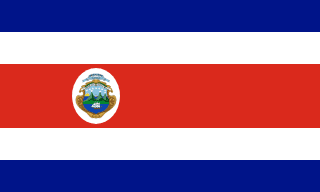Costa Rica - Geography

Here, let us take a look at the Geography of Costa Rica. Four volcanoes, two of them active, rise near the capital of San Jose in the center of the country; one of the volcanoes, Irazu, erupted destructively in 1963-65. Mother's mean age at first birth is (), whereas, the Maternal mortality ratio is 22 deaths/100,000 live births (2020 est.)
Geographical data of Costa Rica
| Location | Central America, bordering both the Caribbean Sea and the North Pacific Ocean, between Nicaragua and Panama |
|---|---|
| Geographic coordinates | 10 00 N, 84 00 W |
| Map references | Central America and the Caribbean |
| Tarrain | coastal plains separated by rugged mountains including over 100 volcanic cones, of which several are major active volcanoes |
| Natural Resources | hydropower |
| Natural Hazards | occasional earthquakes, hurricanes along Atlantic coast; frequent flooding of lowlands at onset of rainy season and landslides; active volcanoes volcanism: Arenal (1,670 m), which erupted in 2010, is the most active volcano in Costa Rica; a 1968 eruption destroyed the town of Tabacon; Irazu (3,432 m), situated just east of San Jose, has the potential to spew ash over the capital city as it did between 1963 and 1965; other historically active volcanoes include Miravalles, Poas, Rincon de la Vieja, and Turrialba |
| Irrigated Land | 1,015 sq km (2012) |
| Major rivers (by length in km) | |
| Major aquifers | |
| Land Boundaries | 661 km |
| Border Countries | Nicaragua 313 km; Panama 348 km |
| Coastline | 1,290 km |
| Climate | tropical and subtropical; dry season (December to April); rainy season (May to November); cooler in highlands |
| Area | |
| Total Area | |
| Land Area | 51,060 sq km |
| Water Area | 40 sq km |
| comparative Area | slightly smaller than West Virginia |
| Maritime Claims | |
| Territorial sea | 12 nm |
| Exclusive economic zone | 200 nm |
| Continental shelf | 200 nm |
| Elevations | |
| Highest point | Cerro Chirripo 3,819 m |
| Lowest point | Pacific Ocean 0 m |
| Mean elevation | 746 m |
| Land Use | |
| Agricultural land | 34.7% (2022 est.) |
| Agricultural land: arable land | arable land: 3.8% (2022 est.) |
| Agricultural land: permanent crops | permanent crops: 6.4% (2022 est.) |
| Agricultural land: permanent pasture | permanent pasture: 24.4% (2022 est.) |
| Forest | 60.1% (2022 est.) |
| Other | 5.3% (2022 est.) |
Population Distribution
Roughly half of the nation's population resides in urban areas; the capital of San Jose is the largest city and home to approximately one-fifth of the population
People and Society
In Costa Rica, the different Ethnic groups are such that we have: White or Mestizo 83.6%, Mulatto 6.7%, Indigenous 2.4%, Black or African descent 1.1%, other 1.1%, none 2.9%, unspecified 2.2% (2011 est.)
| Population | |
|---|---|
| Pop growth rate | 0.74% (2024 est.) |
| Birth rate | 10.8 births/1,000 population (2024 est.) |
| Death rate | 5.3 deaths/1,000 population (2024 est.) |
| Health expenditure | 7.6% of GDP (2021) |
| Physicians Density | |
| Hospital bed Density | 1.1 beds/1,000 population (2019) |
| Total fertility rate | 1.43 children born/woman (2024 est.) |
| Gross reproduction rate | 0.7 (2024 est.) |
| Contraceptive prevalence rate | 70.9% (2018) |
| Est married women (ages 15-49) | 48.4% (2023 est.) |
| Literacy | age 15 and over can read and write |
| Education expenditures | 6.7% of GDP (2020 est.) |
| Net Migration rate | 1.9 migrant(s)/1,000 population (2024 est.) |
| Nationality | Costa Rican | Costa Rican(s) |
| Languages | |
| Religions | Roman Catholic 47.5%, Evangelical and Pentecostal 19.8%, Jehovah's Witness 1.4%, other Protestant 1.2%, other 3.1%, none 27% (2021 est.) |
| Age Structure | |
| 0-14 years | 18.8% (male 506,041/female 482,481) |
| 15-64 years | 70.2% (male 1,862,872/female 1,832,024) |
| 65 years and over | 11.1% (2024 est.) (male 266,568/female 315,589) |
| Dependency Ratios | |
| Total dependency ratio | 45.1 |
| Youth dependency ratio | 29.8 |
| Elderly dependency ratio | 15.3 |
| Potential support ratio | 6.5 (2021 est.) |
| Median Age | |
| Total | 35.5 years (2024 est.) |
| Male | 34.9 years |
| Female | 36.1 years |
| Urbanization | |
| Urban population | 82.6% of total population (2023) |
| Rate of urbanization | 1.5% annual rate of change (2020-25 est.) |
| Major urban areas (Pop) | 1.462 million SAN JOSE (capital) (2023). |
| Sex Ratio | |
| At birth | 1.05 male(s)/female |
| 0-14 years | 1.05 male(s)/female |
| 15-64 years | 1.02 male(s)/female |
| 65 years and over | 0.84 male(s)/female |
| Total population | 1 male(s)/female (2024 est.) |
| Infant Motality | |
| Total | 6.7 deaths/1,000 live births (2024 est.) |
| Male | 7 deaths/1,000 live births |
| Female | 6.3 deaths/1,000 live births |
| Life Expectancy at birth | |
| Total population | 80.3 years (2024 est.) |
| Male | 77.7 years |
| Female | 82.9 years |
| Drinking Water Sources | |
| Improved: urban | urban: 100% of population |
| Improved: rural | rural: 100% of population |
| Improved: total | total: 100% of population |
| Unimproved: urban | urban: 0% of population |
| Unimproved: rural | rural: 0% of population |
| Unimproved: total | total: 0% of population (2020 est.) |
| Sanitation facility acess | |
| Improved: urban | urban: 99% of population |
| Improved: rural | rural: 97.1% of population |
| Improved: total | total: 98.7% of population |
| Unimproved: urban | urban: 1% of population |
| Unimproved: rural | rural: 2.9% of population |
| Unimproved: total | total: 1.3% of population (2020 est.) |
| Alcohol consumption per capita | |
| Total | 3.07 liters of pure alcohol (2019 est.) |
| Beer | 2.17 liters of pure alcohol (2019 est.) |
| Wine | 0.15 liters of pure alcohol (2019 est.) |
| Spirits | 0.36 liters of pure alcohol (2019 est.) |
| Other alcohols | 0.39 liters of pure alcohol (2019 est.) |
| Tobacco use | |
| Total | 8.8% (2020 est.) |
| Male | 12.9% (2020 est.) |
| Female | 4.6% (2020 est.) |
| Child marriage | |
| Women married by age 15 | 2% |
| Women married by age 18 | 17.1% (2018 est.) |
Demographic profile
All Important Facts about Costa Rica
Want to know more about Costa Rica? Check all different factbooks for Costa Rica below.
-
 Costa Rica Factbook
Costa Rica Factbook
-
 The Economy of Costa Rica
The Economy of Costa Rica
-
 Learn about the Government of Costa Rica
Learn about the Government of Costa Rica
-
 Communication in Costa Rica
Communication in Costa Rica
-
 Popular Universities in Costa Rica
Popular Universities in Costa Rica
-
 Enerny in Costa Rica
Enerny in Costa Rica
-
 Transport in Costa Rica
Transport in Costa Rica
-
 The Geography and society of Costa Rica
The Geography and society of Costa Rica
-
 The Environment of Costa Rica
The Environment of Costa Rica
-
 Military and security in Costa Rica
Military and security in Costa Rica